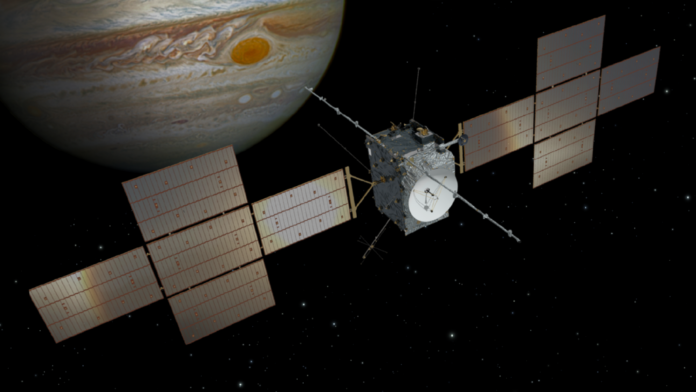The European Space Agency’s JUICE mission will perform a groundbreaking double fly-by of the Moon and Earth, propelling the spacecraft on its way to explore Jupiter’s Icy Moons
In an unprecedented manoeuvre, the European Space Agency’s (ESA) Jupiter Icy Moons Explorer, known as JUICE, is set to make a historic fly-by of Earth tonight. This daring mission, which launched in April 2023, is part of a complex journey to Jupiter, where JUICE will investigate the potential habitability of three of the planet’s largest moons: Callisto, Europa, and Ganymede.
The spacecraft’s trajectory will take it past both the Moon and Earth in a “world first” double fly-by, using the gravitational pull of these celestial bodies to adjust its speed and direction. This gravity assist technique acts as a natural brake, allowing JUICE to save fuel and continue its long journey to Jupiter. Without this manoeuvre, the mission would require an impractical amount of propellant—up to 60,000 kilograms—to reach its destination.
Embed from Getty ImagesFlight controllers at ESA are on high alert as they guide JUICE through this complex operation. Even the smallest error could send the spacecraft off course, potentially ending the mission before it reaches Jupiter. The spacecraft will fly over Southeast Asia and the Pacific Ocean during this critical phase, giving keen stargazers a rare opportunity to spot JUICE in the night sky. With the aid of powerful binoculars or a telescope, some may catch a glimpse of the spacecraft as it passes overhead.
Onboard JUICE are ten scientific instruments designed to explore Jupiter’s moons in unprecedented detail. These include various imaging devices, systems for recording the moons’ surfaces, and sensors to examine their atmospheres. Among these instruments is the UK-developed magnetometer, J-MAG, which will measure the magnetic fields surrounding the moons, providing crucial data on their potential to support life.
The spacecraft’s cameras will be active during the fly-by, capturing images that will be transmitted back to Earth. These photos will offer a visual record of the manoeuvre and will be shared with the public once they are received.
The mission’s next major milestone will occur in August 2025, when JUICE is scheduled to perform a fly-by of Venus. This encounter, along with two subsequent fly-bys of Earth, will provide the necessary energy boosts to propel JUICE towards Jupiter, which lies an average of 800 million kilometres from our planet.
The UK Space Agency has invested around £9 million in the JUICE mission, contributing to the development of several key instruments. Dr Caroline Harper, head of space science at the UK Space Agency, highlighted the significance of tonight’s manoeuvre, calling it “incredibly tricky” and emphasizing the precision required to execute it successfully. “This is a world first: a double fly-by of the Moon and Earth has never been done before… even a tiny mistake could knock JUICE off course,” she noted.
This mission represents a significant achievement for ESA and the international space community. If successful, JUICE will provide invaluable insights into the icy moons of Jupiter, offering clues about the potential for life beyond Earth.
Analysis:
Political:
The JUICE mission exemplifies the collaborative efforts in international space exploration, with Europe taking a leading role in this ambitious project. This endeavour not only highlights the European Space Agency’s growing capabilities but also strengthens political ties between nations contributing to space science. The UK’s involvement, through substantial financial investments and scientific contributions, underscores its commitment to maintaining a presence in global space initiatives post-Brexit. This mission could pave the way for future collaborations in space exploration, potentially influencing political alliances and cooperative efforts in the scientific community.
Social:
Socially, the JUICE mission has the potential to inspire a new generation of scientists and engineers. Space exploration has always captured the public’s imagination, and successful missions like JUICE reinforce the importance of investing in science, technology, engineering, and mathematics (STEM) education. The public’s interest in such missions can drive support for scientific research and development, encouraging governments to allocate more resources to space programs. Moreover, the mission’s focus on exploring potential life-supporting environments on other moons raises profound questions about humanity’s place in the universe, potentially influencing societal debates on life beyond Earth and our responsibilities in exploring it.
Racial:
The JUICE mission, while primarily scientific, also touches on issues of racial equity in STEM fields. Space exploration has historically been dominated by Western and predominantly white institutions. However, the involvement of diverse international teams in missions like JUICE can help to highlight the importance of inclusivity in science. Efforts to engage underrepresented communities in space science through outreach and education programs are crucial for ensuring that future generations of space explorers come from all backgrounds. This mission, therefore, serves as a reminder of the need to make space science accessible to everyone, regardless of race or nationality.
Gender:
Gender representation in space science and exploration remains a crucial issue. The JUICE mission, like many others, provides an opportunity to showcase the contributions of women in STEM fields. Dr. Caroline Harper’s leadership role at the UK Space Agency is a positive example of women taking on prominent positions in space missions. However, the industry still faces challenges in achieving gender balance, particularly in leadership roles. The visibility of women in key roles in the JUICE mission can inspire young women to pursue careers in STEM, helping to address the gender gap in these fields.
Economic:
Economically, the JUICE mission represents a significant investment in space exploration, with the UK alone contributing approximately £9 million. The technological advancements and scientific discoveries resulting from this mission could have far-reaching economic benefits. Innovations developed for space exploration often lead to new technologies and applications in other industries, driving economic growth. Moreover, the success of the JUICE mission could bolster the UK’s and Europe’s positions in the global space economy, attracting further investments and partnerships. The mission also underscores the importance of strategic investments in space science as a driver of economic progress.
